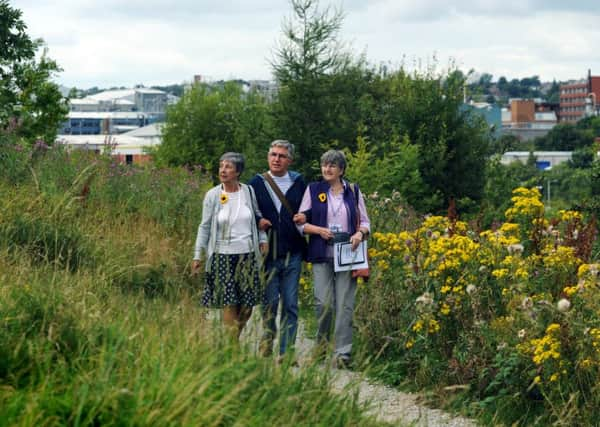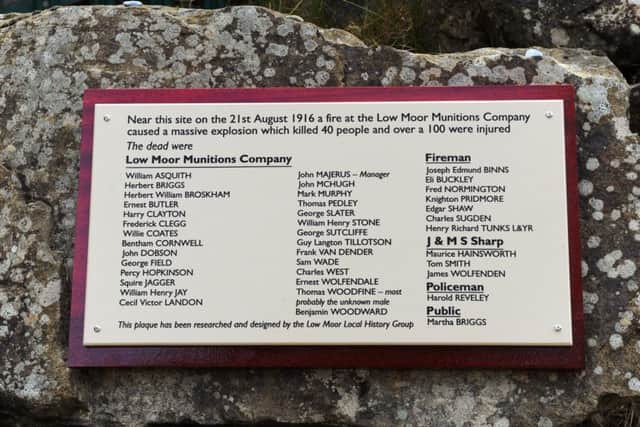Remembering those killed in tragic Low Moor wartime blast


It cost 40 lives. Men, women, factory workers and neighbours; the firefighters and a policeman who came to their aid.
And until now, the full events of the Low Moor Munitions explosion in 1916 have never been fully recorded.
Advertisement
Hide AdAdvertisement
Hide AdWith wartime reporting restrictions, the names of those who lost their lives have never been known. Their story has never been told.


But the diligent efforts of a local history group have uncovered the bare bones. And for the first time, from an unknown man with no name to a career criminal with several, their names have been revealed.
“We remember them,” said Mary Twentyman, of the Low Moor History Group. “That’s what’s important.”
A fire broke out at the Low Moor Munitions Works on August 21, 2016. Factory firefighters tried in vain to battle the blaze, but it soon spread.
Advertisement
Hide AdAdvertisement
Hide AdThey called for help, raising the alarm and calling out to fellow workers to leave as quickly as they could.


“There was about 15 minutes when people could escape before the big explosion,” said Mrs Twentyman. “That saved most people. But a lot of factory workers were killed fighting the blaze. It was their bravery which cost them their lives.”
Bradford firefighters soon arrived on site to help.
“The engine had not been in there long at all when there was a second explosion and it blew up into the air,” said Mrs Twentyman. “By the time it landed back on the ground it was a charred wooden chassis.
“Of the 18 firemen, six were killed and 12 were badly injured.”
Advertisement
Hide AdAdvertisement
Hide AdBut the worst was yet to come. As the blaze spread, it reached a storage area where gas was kept.
“It caused a huge fireball, rumoured to have been seen from as far away as York,” said Mrs Twentyman. “They could only identify the firefighters from the numbers on their axes. They’ve no idea who died how, only by where they were found.”
Mrs Twentyman, with fellow history group member Barbara Reardon, has now researched the stories of those who died.
“One of the men was said to be an ‘unknown man’,” she said. “We think he was Thomas Woodfine, of Kent. Because he was single, nobody saw him off that morning. This poor man has never been properly identified.”
Advertisement
Hide AdAdvertisement
Hide AdA plaque was unveiled yesterday at a site near the disaster 100 years ago.
There have been commemorations before; a statue stands outside fire service headquarters in Birkenshaw and there is a plaque in Victoria Park in Oakenshaw.
But this is unique as it has, for the first time, the names of all 40 who were killed that day.
Paid for by the Low Moor History Group and donations from a local firm, it was unveiled before senior police, fire, and council officials.
And before the descendents of those who died.
Advertisement
Hide AdAdvertisement
Hide Ad“Their families didn’t talk about it,” said Mrs Twentyman. “Some families didn’t know. The people who it really affected kept it to themselves.
“It’s 100 years. But we now know their names.
“We must remember the people who have gone before. We are who we are because of what’s happened in the past.”
Yellow Poppies
The stories of those who died have now been commemorated in a new book, Yellow Poppies.
Written by Barbara Reardon and Mary Twentyman of the Low Moor History Group, it tells the tales of the factory manager who is believed to have been killed trying to save his men.
Advertisement
Hide AdAdvertisement
Hide AdIt also reveals the story of another mystery man, who it turned out was a career criminal operating under several aliases.
“He died under the name of Cecil Victor Landon, but that wasn’t the name he was born with,” said Mrs Twentyman. “We don’t know his real name, but the detectives referred to him as ‘Treacle’. Perhaps he was a sticky character.”
To find out more visit www.lmlhg.org.uk.